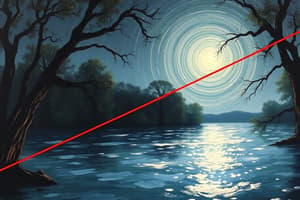Podcast
Questions and Answers
Match each type of motion with its correct definition.
Match each type of motion with its correct definition.
Linear Motion = Movement along a straight line, where all parts of the object travel the same distance in the same time. Circular Motion = Movement along a circular path, which can be uniform (constant speed) or non-uniform. Simple Harmonic Motion (SHM) = Oscillatory motion where the restoring force is proportional to the displacement, leading to repetitive back-and-forth movement. Rotational Motion = Movement of a rigid body around an axis, characterized by torque and moment of inertia.
Match each term with its corresponding unit of measurement.
Match each term with its corresponding unit of measurement.
Displacement = Meters (m) Velocity = Meters per second (m/s) Acceleration = Meters per second squared (m/s²) Angular Velocity = Radians per second (rad/s)
Match each term with its role in projectile motion analysis.
Match each term with its role in projectile motion analysis.
Launch Angle = Determines the initial direction of the projectile, influencing both range and maximum height. Initial Velocity = Affects both the horizontal range and maximum height achieved by the projectile. Range = The horizontal distance covered by the projectile during its flight. Maximum Height = The highest vertical position reached by the projectile during its trajectory.
Match each parameter with its description in Simple Harmonic Motion (SHM).
Match each parameter with its description in Simple Harmonic Motion (SHM).
Match each concept with its corresponding definition related to rotational motion.
Match each concept with its corresponding definition related to rotational motion.
Relate each variable to its role in the equation of motion: $v = u + at$
Relate each variable to its role in the equation of motion: $v = u + at$
Match each concept with its significance in understanding relative motion.
Match each concept with its significance in understanding relative motion.
Match the types of motion with an example.
Match the types of motion with an example.
Match each concept with its corresponding mathematical relationship in physics..
Match each concept with its corresponding mathematical relationship in physics..
Match the quantity with what it measures.
Match the quantity with what it measures.
Flashcards
Displacement
Displacement
Change in position of an object; a vector quantity.
Velocity
Velocity
Rate of change of displacement; a vector quantity.
Acceleration
Acceleration
Rate of change of velocity; a vector quantity.
Circular Motion
Circular Motion
Signup and view all the flashcards
Angular Displacement
Angular Displacement
Signup and view all the flashcards
Angular Velocity
Angular Velocity
Signup and view all the flashcards
Centripetal Force
Centripetal Force
Signup and view all the flashcards
Simple Harmonic Motion
Simple Harmonic Motion
Signup and view all the flashcards
Amplitude
Amplitude
Signup and view all the flashcards
Torque
Torque
Signup and view all the flashcards
Study Notes
- Physics is the science that deals with matter, energy, space, and time
- It explores the fundamental laws governing the universe
Motion Defined
- Motion is the act or process of changing position or orientation in space and time
- It is a fundamental concept in physics, describing how objects move
Types of Motion
- There are several basic types of motion, each characterized by specific properties
Linear Motion
- Linear motion, also known as translational motion, involves movement along a straight line
- All parts of the moving object travel the same distance in the same amount of time
- Key properties include displacement, velocity, and acceleration
Displacement
- Displacement refers to the change in position of an object
- It is a vector quantity, having both magnitude and direction
- Measured in units such as meters (m)
Velocity
- Velocity is the rate of change of displacement with respect to time
- It is also a vector quantity, indicating both speed and direction
- Measured in meters per second (m/s)
- Average velocity is the total displacement divided by the total time taken
- Instantaneous velocity is the velocity at a specific moment in time
Acceleration
- Acceleration is the rate of change of velocity with respect to time
- It is a vector quantity, indicating how quickly the velocity is changing
- Measured in meters per second squared (m/s²)
- Average acceleration is the change in velocity divided by the change in time
- Instantaneous acceleration is the acceleration at a specific moment in time
Equations of Motion
- For uniform acceleration, we use the following equations:
- v = u + at, where v is final velocity, u is initial velocity, a is acceleration, and t is time
- s = ut + (1/2)at², where s is displacement
- v² = u² + 2as
Projectile Motion
- Projectile motion is a type of linear motion where an object is launched into the air and follows a curved path due to gravity
- It can be analyzed by considering the horizontal and vertical components of motion separately
- The horizontal component has constant velocity, assuming no air resistance
- The vertical component has constant acceleration due to gravity, approximately 9.8 m/s²
- Key parameters include:
- Launch angle
- Initial velocity
- Range
- Maximum height
- Time of flight
Circular Motion
- Circular motion involves movement along a circular path
- It can be uniform (constant speed) or non-uniform (changing speed)
- Key concepts include:
- Angular displacement
- Angular velocity
- Angular acceleration
- Centripetal force
Angular Displacement
- Angular displacement is the angle through which an object rotates
- Measured in radians (rad) or degrees (°)
Angular Velocity
- Angular velocity is the rate of change of angular displacement with respect to time
- Denoted by ω (omega)
- Measured in radians per second (rad/s)
Angular Acceleration
- Angular acceleration is the rate of change of angular velocity with respect to time
- Denoted by α (alpha)
- Measured in radians per second squared (rad/s²)
Centripetal Force
- Centripetal force is the force that keeps an object moving in a circular path
- It is directed towards the center of the circle
- F = mv²/r, where m is mass, v is speed, and r is the radius of the circle
Simple Harmonic Motion
- Simple harmonic motion (SHM) is a type of oscillatory motion where the restoring force is directly proportional to the displacement
- Results in repetitive back-and-forth movement about an equilibrium position
- Key characteristics include:
- Amplitude
- Period
- Frequency
Amplitude
- Amplitude is the maximum displacement from the equilibrium position
- Denoted by A
- Measured in meters (m)
Period
- Period is the time taken for one complete oscillation
- Denoted by T
- Measured in seconds (s)
Frequency
- Frequency is the number of oscillations per unit time
- Denoted by f
- Measured in Hertz (Hz), where 1 Hz = 1 oscillation per second
- f = 1/T
Equations of SHM
- Displacement: x(t) = A cos(ωt + φ), where x(t) is displacement at time t, ω is angular frequency, and φ is phase constant
- Velocity: v(t) = -Aω sin(ωt + φ)
- Acceleration: a(t) = -Aω² cos(ωt + φ) = -ω²x(t)
Rotational Motion
- Rotational motion involves the movement of a rigid body around an axis
- Important concepts include:
- Torque
- Moment of inertia
- Angular momentum
Torque
- Torque is a measure of the force that can cause an object to rotate about an axis
- τ = rFsinθ , where r is the distance from the axis of rotation to the point where the force is applied, F is the magnitude of the force, and θ is the angle between the force vector and the lever arm
Moment of Inertia
- Moment of inertia (I) is a measure of an object's resistance to rotational acceleration
- It depends on the mass distribution of the object and the axis of rotation
- Analogous to mass in linear motion
- I = Σmr² for discrete masses, or ∫r²dm for continuous mass distributions
Angular Momentum
- Angular momentum (L) is a measure of an object's rotational motion
- L = Iω, where I is the moment of inertia and ω is the angular velocity
- It is a conserved quantity in a closed system, i.e., without external torques
- Conservation of angular momentum implies that if no external torque acts on a system, its angular momentum remains constant
Combined Motions
- Often, objects undergo combinations of different types of motion simultaneously
- Rolling motion is a combination of translational and rotational motion
- Analyzing combined motions requires considering both linear and angular variables, as well as the relationships between them
- For example, the motion of a rolling wheel can be described by the linear motion of its center of mass and the rotational motion about its center
Relative Motion
- The motion of an object can be described differently depending on the frame of reference of the observer
- Relative velocity is the velocity of an object as observed from a particular frame of reference
- To find the relative velocity of object A with respect to object B (VAB), use the formula: VAB = VA - VB, where VA and VB are the absolute velocities of A and B, respectively
- Understanding relative motion is crucial in many areas of physics, including navigation and collision analysis
Studying That Suits You
Use AI to generate personalized quizzes and flashcards to suit your learning preferences.
Description
Explore the basics of motion in physics, including linear movement, displacement and velocity. Understand how objects change position in space and time. Learn about vector quantities and measurement units.




